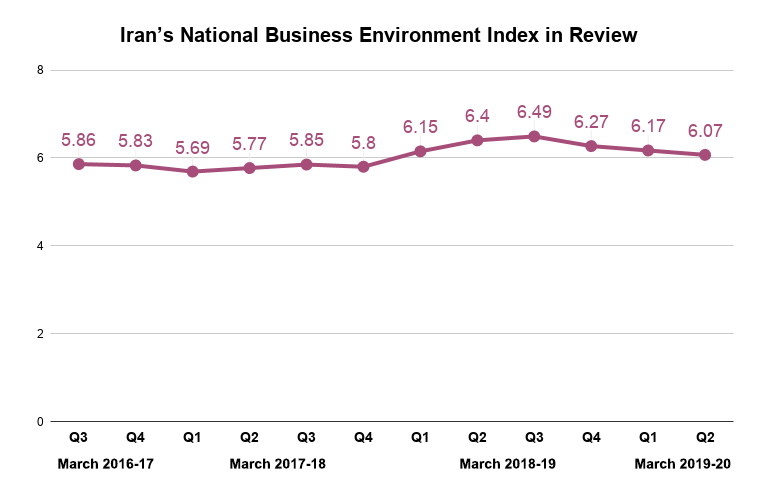The country’s business environment was in fact in its best condition during the past one and a half years in summer, Iran Chamber of Commerce, Industries, Mines and Agriculture reported.
Iran’s National Business Environment Index stood at 6.07 in Q2 of the current fiscal year, registering a decrease of 1.6% compared with the preceding quarter and a decrease of 5.17% over the same quarter of last year.
The index calculated by ICCIMA measures business friendliness of Iran’s economy, with 10 indicating the worst grade, which suggests that the decline in the index is indicative of an improving business environment, according to Financial Tribune.
Iran’s National Business Environment Index stood at 6.17 in Q1 and 6.40 in Q2 of fiscal 2018-19.

“Unpredictability and fluctuations of raw material prices”, “difficulties with getting credit” and “uncertainty about policies, rules, regulations and business formalities” were the most undesirable factors affecting Iran’s business environment in summer, according to the findings of the study.
In fact, “unpredictability and fluctuations of raw material prices” has been the most unfavorable factor in Iran’s business environment during the two years ending Sept. 22, 2019.
On the other hand, “access to energy carriers (electricity, gas and diesel)”, “access to water” and “access to the Internet and mobile phone network” were identified as the three most prominent factors in improving the Q2 environment.
The chamber also measures the index for each of the 31 Iranian provinces. The report has named Sistan-Baluchestan, North Khorasan and Alborz as the provinces with the least favorable environment to do business in, and West Azarbaijan, Gilan and Zanjan provinces as the best.
Agriculture sector had the worst business environment in Q2 with 6.04 points followed by industries (6.01) and services (5.98).
As for 21 fields of business, the worst three were “activities associated with human health and social work”, “information and communications” and “construction”. The top tier included “accommodation and food services” and “water supply, sewage and wastewater treatment”.
Enterprises with more than 200 employees had the best business environment with a score of 5.80 while those with six to 10 employees had the worst business environment with a score of 6.11.
Established businesses of more than 16 years indicated the worst business environment (6.07) while those of fewer than two years were the best (5.81).
The ICCIMA index is fashioned after World Bank’s “Ease of Doing Business” index, the latest edition of which will be published in November.
The World Bank’s Ease of Doing Business Report 2019 showed Iran’s ease of doing business score saw an improvement of 2.34 percentage point, though its ranking among 190 economies fell by four places to 128th.
The country’s overall distance to frontier score was 56.98, compared to the previous report’s (2018) 54.64. An economy’s distance to frontier is indicated on a scale from 0 to 100, where 0 represents the lowest performance and 100 the frontier, WB reported on Wednesday.
Economic Recovery as Sanctions Effects Die Down
Top officials are speaking of economic recovery these days, as the detrimental effects of US sanctions against Iran are said to be dying down.
"Macroeconomic indicators suggest improvement. Reports from every single enterprise confirm this matter," said First Vice President Es’haq Jahangiri recently.
Central Bank of Iran's Governor Abdolnasser Hammati announced last month that growth has returned to Iran's non-oil sector.
"The first three months of the year [13]98 [current Iranian year that started on March 21, 2019], saw the non-oil sector, which is the productive sector of the economy, grow 0.4% compared to the corresponding period of [13]97 [last Iranian year]," the CBI chief wrote in a piece published on the central bank's website.
"Although this growth is well below the potential capacity, considering the negative growth rates of the three preceding quarters and the beginning of decline in inflation, it's a cause for hope," he added.
Hemmati attributed the growth to the return of relative stability in the value of the national currency against foreign currencies and the die-down of external shocks from sanctions and the United States "maximum pressure" campaign against Iran.
"To bolster this growth in the upcoming seasons and to give a boost to productive sectors [of the economy], the banking system has committed to help fund the enterprises," he said, noting that Iranian banks will allocate about 1,000 trillion rials ($8.77 billion) in loans to leading industries in the remainder of the current Iranian year (to end March 19, 2020).
Industries Minister Reza Rahmani said Iran's industrial and mining sector experienced an 18% growth during the first six months of the current Iranian year compared with the preceding year's corresponding period.
Speaking in an inaugural ceremony of a copper concentrate production plant in northwest Iran, Rahmani explained that the production of crude steel, finished steel, cement and glass saw respective growths of 6.5%, 9.1%, 6% and 13% during the same period, IRNA reported.


